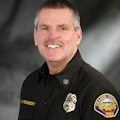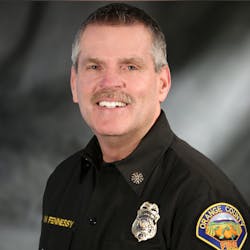Warning: This isn’t an article for those who are looking for tips on how to lead, promote or accept change. The intent is to encourage leaders to accept the great personal, political and organizational risk that they will encounter when they work toward significantly meaningful positive change.
On Sept. 26, 2021, CBS’ “60 Minutes” aired a story that was expected to be a feel-good piece. Its focus was the 24/7 availability of four regionally operated firefighting aircraft, which is a first. It’s an innovative approach on initial and extended attack to concentrate the “speed and force” that’s necessary for rapidly slowing wildland fire spread.
The Quick Reaction Force program/operation isn’t high tech in terms of use of any new or unique emerging technology. It merely is a new combination of capabilities that leverages the use of three incident command system (ICS) Type 1 wildland fire suppression large and very large helitankers, one ICS-qualified aerial supervision-staffed command & control helicopter and a mobile retardant base.
The potential to safely drop water and fire retardant from contract operator-owned heavy helitankers at night has existed for many years. However, other than a handful of Southern California fire agencies that drop water from smaller, agency-owned, multimission aircraft at night, no agency dropped water or retardant at night using large and very large helitankers until now.
In the segment, I passionately stressed that the fire service must evolve immediately, adapt to the realities of this new wildfire era and leave behind its status quo way of doing things. Although the unintended outcome of the story might have resulted in widespread criticism and embarrassment for some, it will result more importantly in much-needed positive change. That said, this isn’t an endorsement for, nor an argument in favor of, the end justifying the means.
The friction that’s between agencies never has been greater, and the story didn’t help with that. The good news is that, since the piece aired, meaningful dialogue now is taking place. To what degree this leads to the organizational adaptation that many of us believe is necessary is unclear, but the opportunity is here for the wildland fire service to embrace change without agency bias.
Accept the risk
This isn’t the first time when change only occurred because of public scrutiny, policymaker-driven pressure and/or agency embarrassment. Clearly, these aren’t the preferred ways to adapt. However, sadly, this has become the most prevalent—and in my opinion, only—means of effecting change.
I have many wildland fire agency friends. After the story aired, I was concerned about the status of those relationships. Many of those friends contacted me. Instead of expressing anger or disappointment, they thanked me.
There are few, if any, commonsense reasons for individuals and/or agencies to resist positive change, particularly with minimal or no fiscal impact. If the change is legal, moral and ethical, why would leaders quietly, but vehemently, resist it? In my experience, ego/pride/jealousy-driven reasons are right at the top of the list.
Nothing brings together members of an organization more closely (even if they don’t care for each other) than a common purpose or a common enemy. Even if an idea represents positive change, loyalty to one’s “patch” can cause an irrational, emotional response.
Retaliation can be expected of any substantive and beneficial change. It manifests itself in both implicit and explicit threats, alienation and even physical harm. Individuals and/or agencies that are determined to marginalize or eliminate resources and/or programs, even if a benefit to the public and fire service, exist. Nevertheless, the “gain” might be worth the “risk” of retaliation.
Perhaps because I am at a certain point in my career, some of the risks and anticipated retaliation concern me less. Of course, the risk is different for every individual who is motivated to push for change.
The fire service needs leaders who are willing to accept the risk that comes with being an outspoken proponent and agent for change. Whether it’s a desire to seek culture change or to develop, support or execute new programs or the expansion of existing resources, it takes courage.
About the Author

Brian Fennessy
Brian Fennessy became fire chief of the Orange County, CA, Fire Authority in 2018. He began his career in 1978 with the U.S. Department of Agriculture’s U.S. Forest Service and the U.S. Department of Interior’s Bureau of Land Management, working as a hotshot crewmember, hotshot/helishot/helitack captain and, ultimately, crew superintendent. In 1990, Fennessy joined the San Diego Fire-Rescue Department (SDFD) and, ultimately, became chief of department in 2015. While he was with the SDFD, he developed and established a fire/rescue/EMS helicopter program. He has a bachelor’s degree in business administration. Fennessy is chair of the FIRESCOPE board of directors and of the California Metropolitan Fire Chiefs Association.
